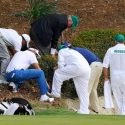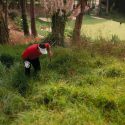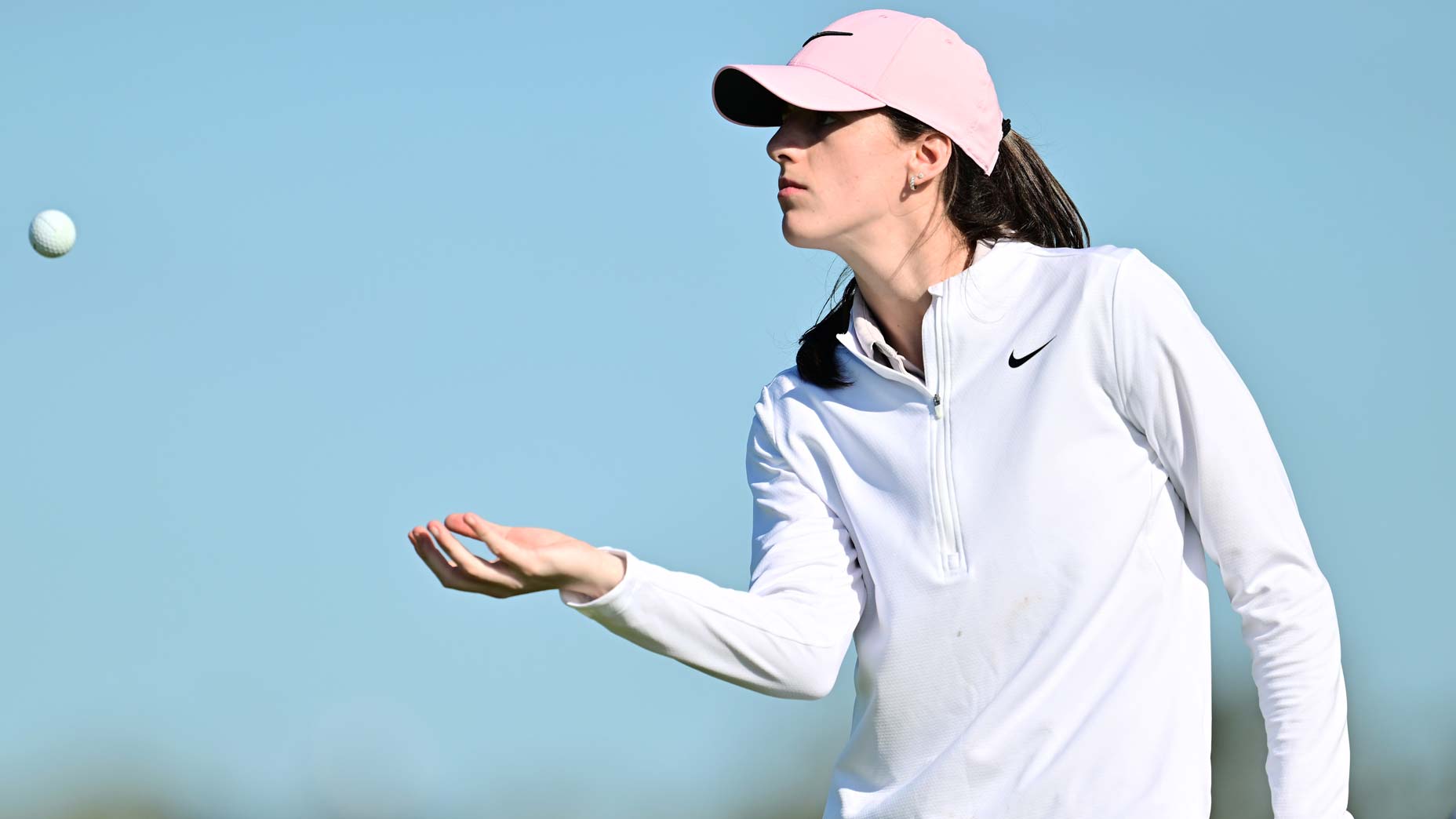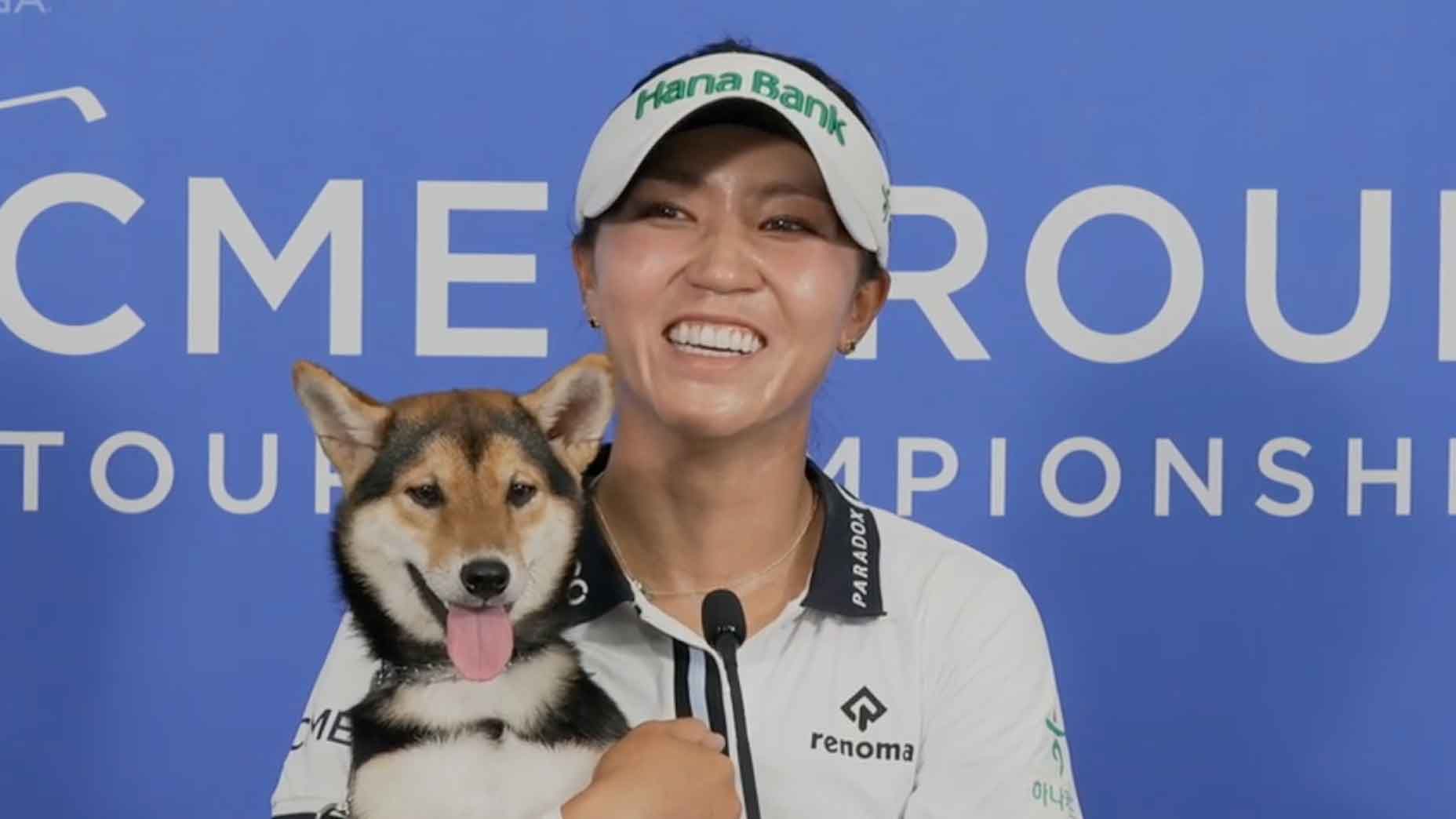 Lydia Ko explains how getting a dog changed her perspective on golf
Lydia Ko explains how getting a dog changed her perspective on golf
Anatomy of a DQ: Billy Mayfair broke two rules in seven holes. Then things got *really* weird

If you follow golf, or just Tiger Woods, closely, you know the name Billy Mayfair. Woods has played in 12 PGA Tour playoffs and has won all of them but one. Mayfair needed only one extra hole, and one timely birdie, to beat Woods at the 1998 Nissan Open, as the Tour’s Los Angeles stop was then known. Mayfair enjoys telling people that he is the answer to a Trivial Pursuit question.
Since that win, Mayfair and his first wife (Tammy) had a protracted and costly divorce, and Mayfair has started a new life with a new wife, Tami Proctor, a former Arizona State golfer. Mayfair, who is 53, turned 50 in August 2016, lost some weight, and started playing the PGA Tour Champions on a full-time basis. He plays in almost every Champions event for which he qualifies, and that’s nearly all of them.
His first senior event was the 2016 U.S. Senior Open, where Mayfair, the 1987 U.S. Amateur champion, finished one shot behind the winner, Gene Sauers. He earned $331,000 that week, and it was welcome. Mayfair won five times and earned over $20 million in his long PGA Tour career, but there had been serious financial setbacks dating back to his early 40s, when his first marriage was breaking up and when he was treated for testicular cancer.
“I’m still struggling,” Mayfair said in a phone interview last week. “I’m working out of the hole. And, fortunately, there’s a Champions tour, to help me get out of that hole.”
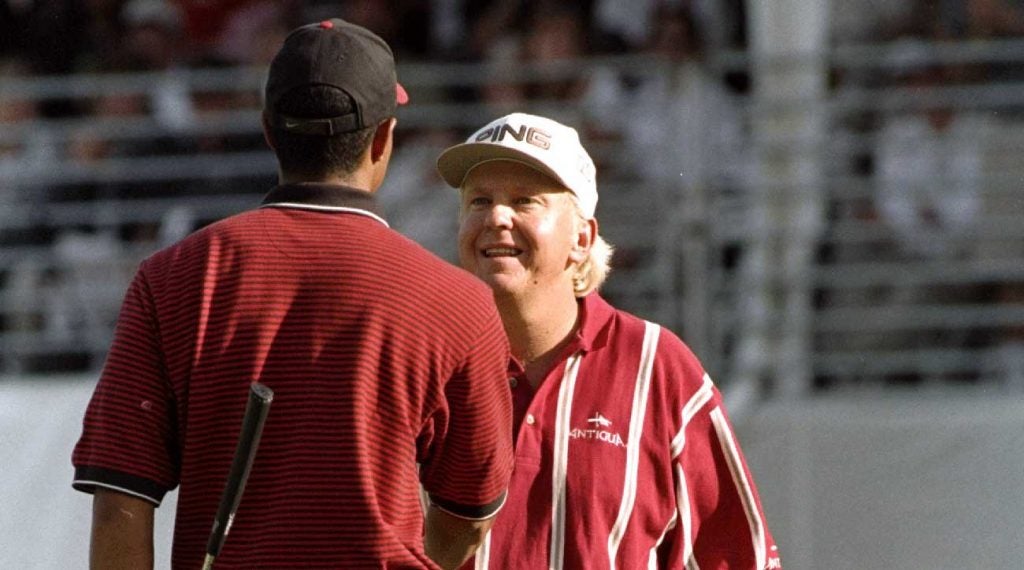
Unfortunately, for Mayfair, he was not in last week’s season-ending event, the Charles Schwab Cup Championship, won in dramatic fashion by Jeff Maggert. The senior-tour year concludes with a playoff, three tournaments in three weeks, and that event, with 34 finishers this year, was the finale.
The season-ender was played in Phoenix, Mayfair’s lifelong home, and for a brief shining moment, Mayfair looked like he might make it to the Phoenix Country Club event, with its $2.5 million purse and $440,000 first-place prize. He needed a good finish in the second playoff tournament to advance.
He got off to an excellent start that week, shooting a first-round 66 in the Invesco QQQ Championship, played at the Sherwood Country Club, near Los Angeles. He was tied for the lead in the three-round tournament with Woody Austin and Miguel Angel Jimenez.
He was paired with Jimenez in the second round in the day’s final twosome. Golf Channel was showing the tournament live. But Saturday was nothing like Friday.
In the space of seven holes, Mayfair had two serious rules issues. By Sunday morning, golf’s two harshest consonants were beside his name, by then at the bottom of the full-field list: DQ. There would be no third-week homecoming. Instead, he was consulting with his lawyer.
Mayfair’s first rules problem on the afternoon — Saturday, Nov. 2 — came on the 11th hole, where he had a lengthy search for his ball and, later, a seemingly inaccurate recounting of the search to a rules official.
His second rules problem came on the 17th hole, where his ball moved at least six inches in the rough. The issue there was not the ball’s movement but how Mayfair described the event to a rules official on the scene, versus what actually happened.
“It’s disturbing,” said Lanny Wadkins in a phone interview. Wadkins, the World Golf Hall of Fame member who first started playing the PGA Tour in 1971, was at Sherwood as the lead Golf Channel analyst.
Wadkins talked about how strict adherence to the rules was the necessary starting point for all tournament golf, whether on TV or not. Without complete faith in the scores tournament golfers say they shoot, competitors cannot trust each other and golf fans cannot trust what they are watching.
Referring to the ball movement on 17, and how Mayfair described it to the official, Wadkins said, “We’re like, ‘Whoa, wait a minute. That’s not what happened.’ We hate seeing that. It puts us in a bad position.” It also puts golf in a bad light.
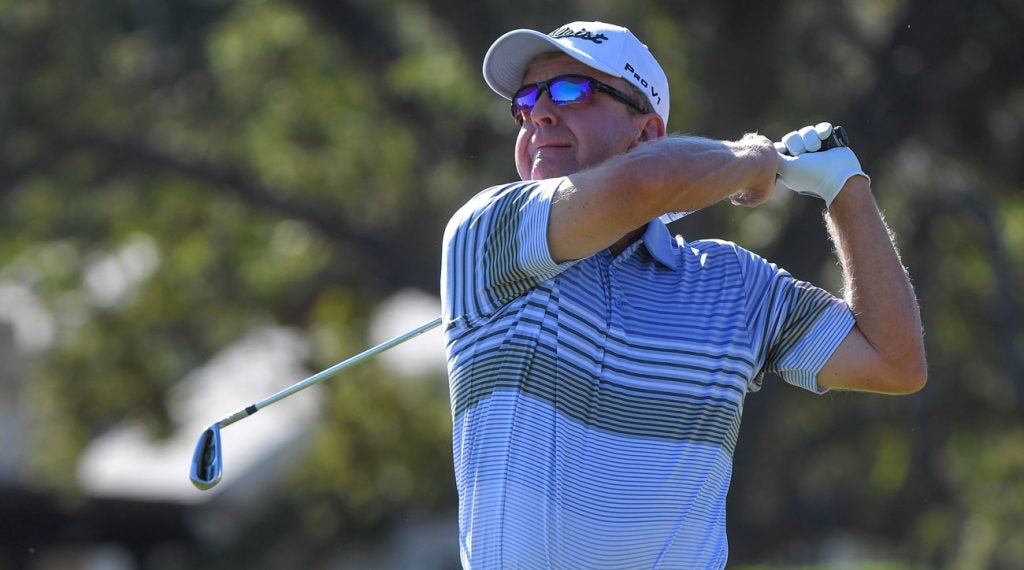
Two Golf Channel employees said the clip could not be shared with GOLF.com because broadcast rights revert to the PGA Tour 48 hours after a tournament concludes. Tom Alter, a vice president in the PGA Tour’s communications department, said the Tour could not make available a clip of Mayfair on the 17th hole, citing Tour policy. Asked about providing a transcript of the 15-second conversation between Mayfair and the official, Alter said, “We don’t have the resources for that.”
The ball search on the 11th hole was not shown on Golf Channel, although it was taped by the cable network.
Mayfair’s Saturday round was ordinary enough, for a while. He was one under for the day through 10 holes. On 11, a par-5, he hit a shot in the left rough that he and his caddie struggled to find.
Mayfair searched for his golf ball. So did his wife and Jeff Johnson, his caddie. Mayfair, in a phone interview monitored by his lawyer, said Jimenez “got on his hands and knees and searched as hard as I was.” Spectators came in, to help with the search. Two rules officials, first Tom Carpus, later Dean Ryan, arrived. Mayfair and Jimenez were out of position, though not on the clock, so the officials were close by. Everybody was looking for a Titleist ProV1X with two small red dots on either side of Titleist and a bigger black dot above the e.
Mayfair said, “I had told Jeff to keep an eye on his watch. We knew it was getting close to the three minutes.”
Eventually, Johnson found it. There was grass swarming it, but it was Mayfair’s ball.
Whew.
Mayfair asked Carpus if he was entitled to embedded ball relief. For a ball to be embedded it has to break the surface of the ground and remain in its pitchmark. Carpus said Mayfair’s ball was not embedded. Mayfair played on. He said there was no discussion of the time it took him to find the ball. It took him a total of seven shots to get his ball in the hole.
ADVERTISEMENT
In tournament golf, a golfer who doesn’t find his or her ball within three minutes is deemed to have lost it and must go back to where the previous shot was played, under stroke-and-distance penalty. The clock begins when the player or caddie arrives in the vicinity of where the ball is expected to be. The allowed search time had been five minutes for decades but this year it was changed to three. In the phone interview, Mayfair was asked if he knew about the change in the rule.
“Absolutely, I did,” Mayfair said. “Yes.”
After 11, Mayfair played the next five holes in even par. Then, on the par-3 17th, Mayfair missed the green with his tee shot and his ball came to rest in four-inch long grass on a severe upslope between a greenside bunker and an elevated green. Jimenez was on the green.
Mayfair walked to his ball and, holding his 60-degree wedge with only his right hand, stood over it in the customary address position. He put the heavy sole of his wedge in the grass behind the ball. Viewers of the Golf Channel telecast could see that clearly, via a camera set up directly behind Mayfair. The clubhead went into the grass and the ball suddenly rolled both downhill and sidehill. It was an odd, unexpected sight, but the blades of Sherwood’s long, perennial ryegrass rough were damp and weak and golf courses are incubators for the odd and unexpected anyhow. The ball rolled in the rough, on that slope, at least a half-foot.
Mayfair, wearing wraparound shades in the autumn afternoon glare, turned around, in the direction of the Golf Channel camera, and looked for a rules official. One, Dean Ryan, happened to be nearby. Golf Channel boom mics picked up their conversation. This is all of it.
“My ball was right here,” Mayfair said, using his club as a pointer. “I got over it. I did not touch it, I did not get near it.”
“OK, no problem, if you did nothing to cause it to move,” Ryan said.
Mayfair talked over Ryan’s last four words.
“I had the club up by it, but it was not in the ground,” Mayfair said.
“You’re good,” Ryan said.
“Thank you,” Mayfair said. He waved his hand.
He then pitched on and took two putts.
“That club was definitely down in the grass,” Phil Blackmar said on the telecast. The former Tour player is now a Golf Channel broadcaster.
He and Wadkins were watching a replay.
“I don’t know that he grounded it, but it wasn’t above the grass, like he described to the official,” Wadkins said.
Brian Claar, 60, a longtime Tour player, and now the head rules official for the Champions tour, saw Mayfair briefly after Mayfair finished the round. He asked Mayfair if there had been any issues with the length of time it took him to find his ball on 11.
“I said, ‘[It took] three minutes, and he said, ‘OK, fine,’” Mayfair said in the interview. “We were done and he walked away.”
Mayfair went to the scorer’s trailer, intending to sign for a 74, with a 7 on 11 and a 4 on 17.
Claar went to the Golf Channel compound. Once there, he asked a rules official in the scorer’s trailer to ask Mayfair to come to the broadcast truck before he signed his card and made it official. Mayfair arrived at the compound and Claar showed him the tape of what had transpired on 17.
In a phone interview, Claar said that Mayfair acknowledged that he had caused the ball to move after watching the clip twice. By the rules, he should have moved the ball back to its original position and incurred a one-shot penalty. By failing to do so, the rules required a two-shot penalty, meaning he had made 6 on 17 and not a 4. Mayfair signed for 76.
“We caught it in time,” Claar said in an interview.
“I never knew how close to the grass the club was until I saw it on tape,” Mayfair said in a separate interview.
The second round was over. Mayfair left the course. He was scheduled to play in the Sunday round at 12:30 p.m., with Duffy Waldorf. Mayfair thought that if he had a great Sunday round he could still qualify for the third event, the grand finale, and sleep at home while playing in it. He figured he’d need to go really low, a 63 or something close to it.
Before Claar left Sherwood on Saturday, he said he received a call from the volunteer scorer who was walking with the Mayfair-Jimenez twosome. The scorer, Claar said, “was adamant that it took Billy well over three minutes to find the ball.” The source of the information was too reliable to be ignored, Claar said.
Sunday morning, Claar went back to the Golf Channel compound. At around 8:30, he was able to get access to the feed that showed the ball search on 11, even though it was not shown on the broadcast. Claar said there was a timer on the footage. He determined it took somewhere between 4 minutes, 50 seconds, and 4 minutes, 55 seconds, for Mayfair to find his ball.
About two hours later, Mayfair arrived on the range, to warm up for the third round. “I told Billy it took him between 4:50 and 4:55 to find the ball,” Claar said. “He said, ‘Well, we have a five-minute search.’ I said, ‘No, the rules have changed this year. It’s three minutes.’ He said, ‘I didn’t realize that.’ I explained that the ball you played is deemed lost. You played the wrong ball.”
Mayfair said that is not how he remembers the conversation. He said that Claar told him he took between 4 minutes and 4 minutes and 30 seconds to find the ball, and that he did not say he was unaware of the rule change.
Claar said he offered Mayfair the opportunity, on the Sherwood range on that Sunday morning, to go to the Golf Channel compound and watch the replay himself, but that he did not want to do that. “I guess he believed me,” Claar said. “He was upset.”
The rules don’t permit play with a ball that’s out of play. Once Mayfair was over the time limit, his only recourse was to go back from where he had played his previous shot. He never finished the 11th hole, which means he did not have a second-round score he could submit.
“You could say he disqualified himself the second he hit his tee shot on 12,” said David Fay, the former USGA executive director and the rules expert for the USGA events on Fox. Before hitting that shot, Mayfair could have realized that he had not finished the 11th hole in accordance with the rules and returned to the hole and play it for an official score. But once he started 12, 11 was in the books. And the box for 11 had no score. Viewed that way, Mayfair never actually played 12 through 18, either. His tournament was already over, Fay noted. He just didn’t know it yet.
Fay was working for the USGA when Mayfair won his U.S. Amateur title (he also won the 1986 U.S. Amateur Public Links). The great USGA rules authority in that period was P.J. Boatright, whom Mayfair knew from his play in USGA events, including the Walker Cup.
“What I always got from P.J. Boatwright was that the rules officials were always there to help the players, they were there not to call penalties on you, not just to try to get you disqualified,” Mayfair said.
Fay and others say that players say that, but it oversimplifies the role of rules officials. The essence of the job is to make sure the rules are applied correctly and uniformly. The officials are not there to help or hurt. Their interest is in fair play.
“I wish this could have been handled more on an on-the-level basis,” Mayfair said. “It could have been handled better.”
Handled better by whom, Mayfair was asked.
“By the rules officials,” Mayfair said. “They see me searching for the ball. They know how long I’m looking for it. They have a stopwatch and I don’t.”
Again, rules authorities disagree. They say that a central element of golf is for each individual golfer to know the rules and follow them. The rulebook contains this sentence on its first page: “You are responsible for applying your own penalties if you breach a rule, so that you cannot gain any potential advantage over your opponent in match play or other players in stroke play.”
Mayfair was asked if there were instances in his 30-year professional career where he has called penalties on himself.
“Let me try and see, I think I have,” Mayfair said. “Well, I’ll give you a perfect example. I called that two-shot penalty on myself at 17. Once I saw that the ball had moved, I said it moved. So, yes, I believe I called it on myself.”
Mayfair said that he had never had a DQ in any tournament before.
Regarding that Sunday round where he never made it to the first tee, Mayfair had this to say: “I wanted to play, but obviously if I broke the rules, I had to disqualify myself.”
Michael Bamberger may be reached at Michael_Bamberger@golf.com.
ADVERTISEMENT






